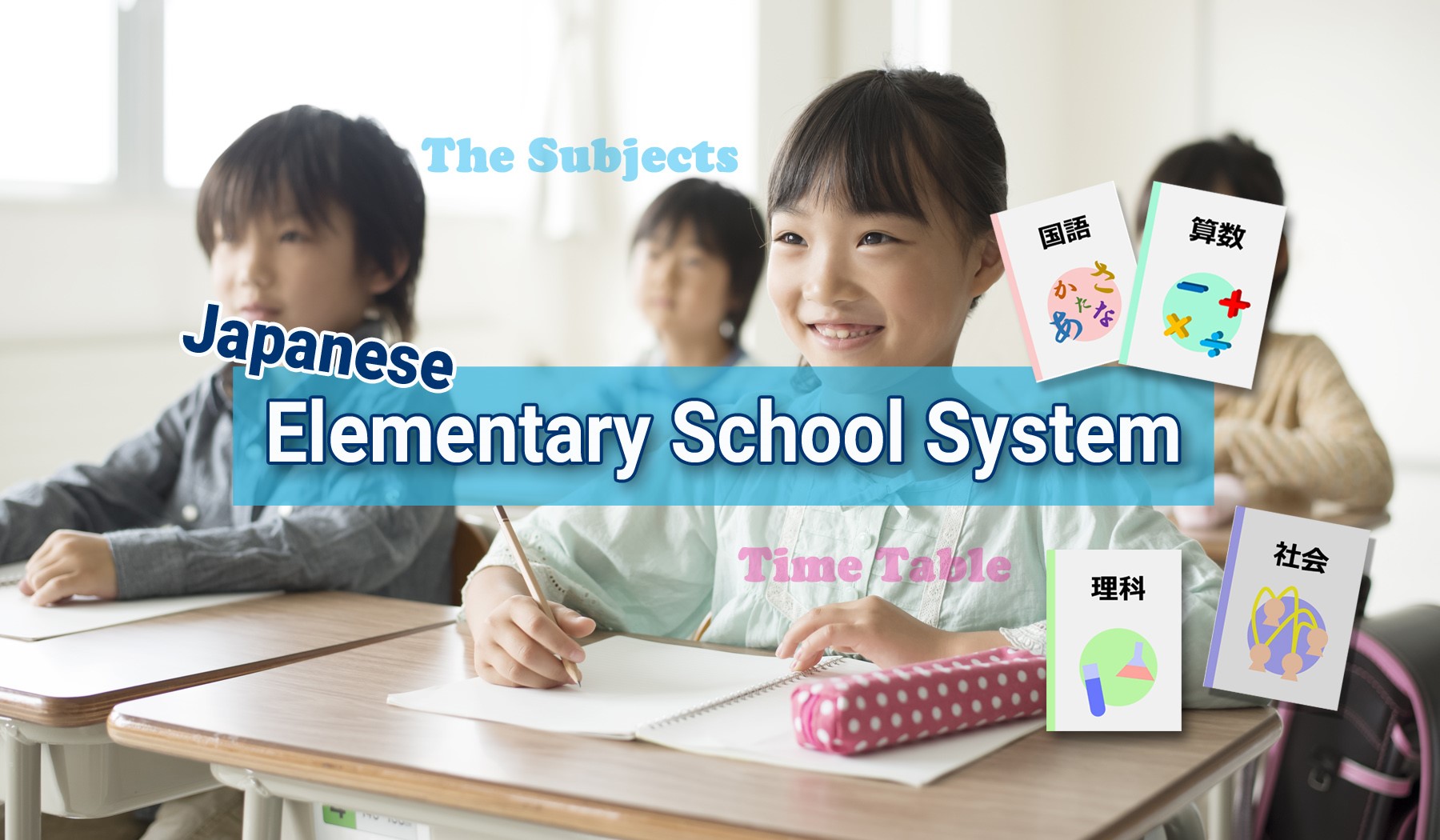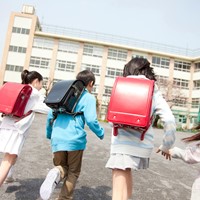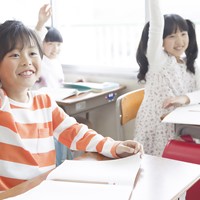Primary - Elementary School System in Japan

You may be wondering what children in Japan are learning in elementary school and how they spend their day along with what unique subjects are taught in Japan that are not found in foreign countries. In this article, you will learn about the subjects taught at Japanese elementary schools and a typical daily schedule for students.
Note: The system below is current as of March 13, 2023, and this page is not guaranteed to be up-to-date. The system is subject to change, so please check the Ministry of Education, Culture, Sports, Science and Technology website for the most up-to-date information.
If you would like to know about the custom of Japanese public elementary schools, this article has a great explanation.
> Japanese Daycares, Preschools & Kindergartens—How Do They Work?
> List of International Schools in Japan
Number of school hours spent on each subject in a Japanese Elementary School
Below is the number of class hours that must be dedicated to each subject throughout the year according to the Ministry of Education, Culture, Sports, Science and Technology. Did you notice any classes that you are unfamiliar with? Please read further for more information about what they are.
*swipe or scroll to see the complete table
| Subjects / Grades | Grade 1 | Grade 2 | Grade 3 | Grade 4 | Grade 5 | Grade 6 |
| Japanese Language | 306 | 315 | 245 | 245 | 175 | 175 |
| Social Studies | - | - | 70 | 90 | 100 | 105 |
| Elementary Mathematics | 136 | 175 | 175 | 175 | 175 | 175 |
| Science | - | - | 90 | 105 | 105 | 105 |
| Living Environment Studies | 102 | 105 | - | - | - | - |
| Music | 68 | 70 | 60 | 60 | 50 | 50 |
| Art and Handcraft | 68 | 70 | 60 | 60 | 50 | 50 |
| Home Economics | - | - | - | - | 60 | 55 |
| Health and Physical Education | 102 | 105 | 105 | 105 | 90 | 90 |
| Ethics (Moral Education) | 34 | 35 | 35 | 35 | 35 | 35 |
| Special Activities | 34 | 35 | 35 | 35 | 35 | 35 |
| Integrated Studies | - | - | 70 | 70 | 70 | 70 |
| Foreign Language Activities | - | - | 35 | 35 | - | - |
| Foreign Language | - | - | - | - | 70 | 70 |
| Total Numbers of Classes | 850 | 910 | 980 | 1015 | 1015 | 1015 |
Data from Ministry of Education, Culture, Sports, Science and Technology
The Subjects taught at a Japanese Elementary Schools
Below are subjects that may not be common in other countries.
Source: MEXT: 小学校学習指導要領解説
Social Studies (Shakai - 社会)
Through activities that enable students to use social perspectives and ideas to pursue and solve problems, aiming to develop the basic civic qualities and abilities necessary to become a peaceful, democratic nation and society in a globalized international society.
Grade 3
To understand the geographical environment of familiar areas and municipalities, various activities for local safety, local industries and consumer life, and changes in local conditions, based on the relationship with people's daily lives.
Grade 4
Understand the characteristics of the geographical environment of their own prefectures, the functions that support the health and living environment of local people, various activities to protect local safety from natural disasters, local traditions and culture, and the work of predecessors who contributed to the development of the region, based on the relationship with people's daily lives.
Grade 5
Understanding of the geographical features of Japan's land environment, the current state of industry, and the relationship between the informatization of society and industry, based on the relationship with people's daily lives.
Grade 6
Understanding of Japan's political system, its structure and functions, the achievements and outstanding cultural heritage of our predecessors who played an important role in the development of the nation and society, the lives of countries closely related to Japan, and the role of Japan in the globalizing international society.
Living Environment Studies (Seikatsu - 生活)
Through concrete activities and experiences, aiming to cultivate qualities and abilities that will enable students to become independent and enrich their lives by making the most of their views and ideas related to everyday life.
Music (Ongaku - 音楽)
Through activities of expression and appreciation, aiming to cultivate the following qualities and abilities that will enable students to use their musical perspective and thinking, and to relate to the sounds and music in their daily lives and in society in abundance.
(1) To understand the relationship between musical ideas and the structure of music, and to acquire the skills necessary for expressing the music they wish to express.
(2) To be able to devise musical expressions and to listen to music with appreciation.
(3) Through experiencing the joy of musical activities, to develop a love of music and sensitivity to music, as well as to cultivate an attitude of familiarity with music and cultivate rich emotionality.
Students learn about singing, playing musical instruments such as a recorder, a keyboard harmonica, reading music notes etc.
You may also be interested in reading Enrolling in a Japanese public school and materials you need to prepare.
Art and Handcraft (Zugakousaku - 図画工作)
Through activities of expression and appreciation, the children will develop the following qualities and abilities that will enable them to use their own creative perspectives and ideas, and to relate to the shapes and colors of daily life and society in abundance.
(1) To understand through their own senses and actions the figurative viewpoints that perceive objects and events, and to be able to create and express themselves creatively by using materials and tools and devising ways to express themselves.
(2) To think about the goodness and beauty of art, what they want to express, and how they want to express it, and to develop creative ideas and concepts, as well as to deepen their own perspectives and feelings about their works.
(3) To experience the joy of creating, to nurture sensitivity, to cultivate an attitude to create a joyful and rich life, and to cultivate rich emotionality.
Home Economics (Katei - 家庭)
The goal of the program is to develop the following qualities and abilities to improve their lives through practical and experiential activities related to food, clothing, shelter, and other aspects of daily life, by exercising their viewpoints and ways of thinking.
(1) To develop a basic understanding of the family, home, food, clothing, shelter, consumption, and the environment necessary for daily life, and to acquire the skills necessary for these areas.
(2) Cultivate the ability to solve problems by finding problems in daily life, setting issues, thinking of various ways to solve them, evaluating and improving practices, and expressing what they have thought.
(3) Cultivate a practical attitude to cherish family life, think about relationships with family and community members, and devise ways to improve life as a member of a family.
Health and Physical Education (Taiku / Hoken-Taiku - 体育 / 保健体育)
Through the process of learning to see and think about physical education and health, to identify issues, and to solve them, we aim to develop the qualities and abilities needed to maintain and improve physical and mental health throughout life and to realize a rich sports life, as follows.
(1) To understand how to perform various types of exercise according to their characteristics, as well as health and safety in their daily lives, and to acquire basic movements and skills.
(2) To discover one's own issues regarding exercise and health, to think and judge in order to solve them, and to develop the ability to communicate them to others.
(3) To foster an attitude to lead a happy and cheerful life by becoming familiar with exercise and aiming to maintain and improve health and physical fitness.
Health and Sexuality Education
Starting from the 4th grade, both boys and girls will learn about growth and development. They will learn about individual differences in height and weight gain, changes in physical constitution, menstruation and the function of hormones.
Mental health (Grade 5-6)
Guidance will be given on mental health so that students can learn the following through activities aimed at identifying and resolving issues.
(1) Understand the development of the mind and how to cope with anxiety and worries, as well as simple ways to deal with them.
(2) The mind develops with age through various life experiences.
(3) The mind and body are closely related.
(4) There are various ways to cope with anxiety and worries, such as talking to adults and friends, playing with friends, and exercising.
Disease Prevention (Grade 5-6)
Through activities aimed at identifying and solving problems regarding the prevention of disease, students will be guided to acquire the following
(1) Understanding of disease prevention.
(2) Diseases are caused by the relationship between pathogens, body resistance, lifestyle behaviors, and the environment.
(3) To prevent diseases caused mainly by pathogens, it is necessary to prevent pathogens from entering the body and to increase the body's resistance to pathogens.
(4) In order to prevent diseases caused mainly by lifestyle-related diseases, it is necessary to develop desirable lifestyle habits, such as appropriate exercise, a diet free of unbalanced nutrition, and oral hygiene.
(5) Behaviors such as smoking, drinking alcohol, and drug abuse are causes of poor health.
Foreign Language Activities (Gaikokugo katsudo - 外国語活動)
Grade 3-4
The goal is to cultivate the following qualities and abilities that will provide the basis for communication through listening and speaking language activities in English, while encouraging students to use their views and ideas in communicating in the language.
(1) Through English, to deepen their understanding of language and culture through experience, to become aware of the phonetic differences between Japanese and foreign languages, and to become familiar with the phonetic sounds and basic expressions of English.
(2) Cultivate the students' ability to communicate their thoughts and feelings by listening to and speaking about familiar and simple matters in English.
(3) Through English, deepen their understanding of languages and the cultures behind them, and develop an attitude to communicate proactively using the language while taking others into consideration.
Foreign Language (Gaikokugo - 外国語)
Grades 5-6
The goal is to develop the following qualities and abilities that form the basis for communication through language activities such as listening, reading, speaking, and writing in a foreign language, while developing ways of seeing and thinking about communication in English.
(1) To become aware of the differences between Japanese and English in terms of sound, letters, vocabulary, expressions, sentence structure, language functions, etc., to understand this knowledge, to become familiar with reading and writing, and to acquire basic skills that can be used in actual communication through listening, reading, speaking, and writing in a foreign language.
(2) To develop the basic skills to communicate one's thoughts and feelings by listening and speaking about familiar and simple matters according to the purpose, scene, and situation of communication, as well as reading while guessing vocabulary and basic expressions in English which they are fully familiar through speech, and writing while being conscious of word order. Cultivate the basic ability to communicate one's thoughts and feelings.
(3) Deepen understanding of the culture behind the foreign language and cultivate an attitude to communicate proactively using the foreign language with consideration for others.
Ethics / Moral Education (Doutoku - 道徳)
In order to cultivate the moral character that is the foundation for a better life, cultivate moral judgment, feelings, and the will and attitude to practice through learning to look at oneself, to think about things from multiple perspectives and from multiple angles, and to deepen one's ideas about one's own way of life, based on an understanding of moral values.
Integrated Studies
Students should actively incorporate social experiences such as nature experiences and volunteer activities, hands-on activities such as manufacturing and production, observation and experimentation, observation and investigation, and presentations and discussions into their learning activities.
Through the use of inquiry-based views and thinking, and through cross-curricular and integrated learning, aim to develop the qualities and abilities to better solve problems and think about one's own way of life, as follows
(1) In the process of inquiry-based learning, acquire the knowledge and skills necessary to solve problems, form concepts related to problems, and understand the advantages of inquiry-based learning.
(2) To discover questions from the real world and real life, set their own agenda, gather information, organize and analyze it, and summarize and express it.
(3) To engage independently and cooperatively in inquiry-based learning, and to cultivate an attitude of active participation in society while making the most of each other's strengths.
Learning activities to acquire logical thinking skills while experiencing programming
In the process of exploratory learning, students should devise learning activities such as collecting, organizing, and transmitting information through appropriate and effective use of computers and information communication networks. In doing so, students should acquire the basic operations of information tools necessary as a foundation for learning, such as typing on a computer, and should be able to independently select and use information and information tools.
Volunteer and hands-on activities
Students should actively engage in social experiences such as nature experiences and volunteer activities, hands-on activities such as manufacturing and production, and learning activities such as observation, experimentation, observation, investigation, presentation, and discussion.
Special Activities
These include school events, arts and sciences faires, exhibitions, concerts, athletic meet, excursions, volunteer work, group accommodation activities etc.
Timetable of a Day at Japanese Elementary Schools

This is how elementary school students spend their time at school, the flow of the day. Depending on the school, the content may differ from what is described. However, this is what most public elementary schools follow.
Timetable of a Day at Primary Schools in Japan
*swipe or scroll to see the complete table
| Arriving | 8:00 ~ 8:25 |
| Morning assembly for the whole school, homeroom, etc. | 8:25 ~ 8:35 |
| 1st class | 8:35 ~ 9:20 |
| 2nd class | 9:25 ~ 10:10 |
| Break | 10:10 ~ 10:30 |
| 3rd class | 10:30 ~ 11:15 |
| 4th class | 11:20 ~ 12:15 |
| Lunch | 12:15 ~ 13:00 |
| Break | 13:00 ~ 13:20 |
| Cleaning | 13:20 ~ 13:40 |
| 5th class | 13:40 ~ 14:25 |
| 6th class | 14:30 ~ 15:15 |
| End-of-the-day homeroom (for 5 classes)* | 14:25 ~ 14:35 |
| End-of-the-day homeroom (for 6 classes)* | 15:15 ~ 15:25 |
* After the lunch break or the end-of-the-day homeroom (depends on the school), students clean their classroom and/or common parts of school building. In most cases the lower grade students (first and second grade) are supported by elder students.
Arriving
School hours start at around 8:00 - 8:20. Depending on the area, students walk to school in a group, or are led by guardian (one of the student's parents).
Morning Meeting
The morning meeting is from 8:25 to 8:35. At the morning meeting, the teacher provides information necessary, and does things such as checking the physical condition of all their students, check the schedule for today, and hand out submissions.
Class Hours
The first class starts around 8:45. Each class' duration is 45 minutes.
Breaks
Between classes there are breaks which last about 5-10 minutes. During this time, students prepare for the next lesson, move to the classroom etc. In addition, there is a 20-minute break between the 2nd and 3rd hours.
Lunch
After 4 classes in the morning, the lunch is scheduled from 12:15 to 13:00. The time allocation is considered to be about 15 minutes for preparation, 20 minutes for meals, and 10 minutes for tidying up. Students take turns to serving lunch and cleaning up.
Lunch Break
13:00 to 13:20 is the lunch break time. When the weather is good, students play on the playground, and when it rains, they spend time in the library or classrooms.
Cleaning
From 13:20 to 13:40 after the lunch break, everyone cleans up the school. The place to clean is shared. Some schools schedule the cleaning time after lunch and some schools do it after lunch break.
End-of-the-day Meeting
The closing meeting is held for about 10 minutes after all the lessons are over. The teacher gives out prints for students to give to their parents, talks about the day, and provide information.
Going Back Home
Some schools organize groups and students to go back home together in a group.
What about Saturdays?
Due to the increase in the number of classes, the number of elementary schools that hold classes once or twice a month on Saturdays is increasing. In addition to regular classes, Saturday classes may include various school events such as extra classes, athletic events, and parents' visits.
You may also be interested in:
* List of International Schools in Japan
* Japanese education system and which school is the best for your child
* Enrolling in a Japanese public school and materials you need to prepare















